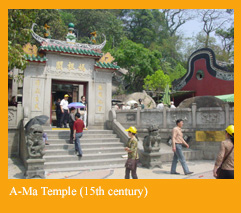|
Macau,
the World Heritage
By
Sarah Hong, Sharon Lai, Rachel Leong, Jessie Un
 Macau is the only city of China which bid for a site of Cultural
and Natural Heritage in the 28th World Heritage Convention in 2004.
Will the "Historical Monuments of Macau" be successfully
listed as the World Heritage? The final result will be announced
in the 29th World Heritage Convention (July 10-16) this summer.
Macau is the only city of China which bid for a site of Cultural
and Natural Heritage in the 28th World Heritage Convention in 2004.
Will the "Historical Monuments of Macau" be successfully
listed as the World Heritage? The final result will be announced
in the 29th World Heritage Convention (July 10-16) this summer.
However,
most people, both tourists and local residents have little knowledge
about this event, according to a survey conducted by this group
of reporters of Umac Bridges. The interviews were conducted at the
Senado Square in Macau on March 15. Among 100 people (50 locals
and 50 tourists) interviewed, most of them didn't know anything
about Macau's bid for the World Heritage. Only about 30 percent
of local people and 20 percent of tourists, mainly from Hong Kong,
heard of this news.
Of 50 tourists interviewed, about 70 percent were Hong Kong people,
20 percent tourists from mainland of China, 10 percent from foreign
countries, including America, Australia, England, etc.
The
World Heritage Committee is an intergovernmental organization under
the United Nations Educational, Scientific and Cultural Organization
(UNESCO) for the preservation of the cultural and natural heritage
of priceless universal value.
Until
now, the World Heritage Committee has listed 788 World Heritage
monuments in 134 countries. They include 611 of the World Cultural
Heritage, 154 of the World Natural Heritage and 23 of the Cultural
and Natural Heritage. Spain is the country with the most World heritage
monuments followed by Italy and China.
Many
years ago, Macau was just a fishing port. But now Macau is an internationally
recognized city full of cultural characteristics. Its tourism and
casino industries are famous all over the world. After more than
400 years of colonization by Portugal, Macau became a nexus where
Eastern and Western cultures met and mingled. The results of this
combination of cultures can be seen today in baroque-style churches
and exotic temples, pastel-colored palaces and classic Chinese gardens.
Because
of the unusual cultures in Macau, the Central Government of the
People's Republic of China submitted Macau's bid to the UNESCO's
World Heritage Center in 2001, and it succeeded in being accepted
after a technical analysis by the Center in 2003. The result will
be declared in the 29th Session of the World Heritage Committee
this year.
The
"Historical Monuments of Macau" are composed of Barra
Temple, Harbour Captaincy, Mandarin's House, Church and Seminary
of St. Joseph's, Dom Pedro V Theatre, Building of Civic and Municipal
Affairs Bureau, Santa Casa da Misericórdia, Ruins of St.
Paul, Na Tcha Temple, Section of the old city walls, Fortress of
Our Lady of the Mount, and Guia Fortress (including Guia Chapel
and Guia Lighthouse).
There
are many unique style buildings in Macau. However, most of Macau
people and tourists do not recognize the values of the heritages.
Richard
Stone is a tourist from America who came to Macau for the first
time said that he had never thought that Macau would qualify to
apply for the World Heritage.
A
Hong Kong tourist Peter Chan said, 'I've heard of the news from
newspapers. I believe that Macau buildings are so special and Ruins
of St. Paul is the best symbol of Macau.'
Check
Hoi Man, a Macau resident said, 'I am proud of Macau which has a
lot of Portuguese feature buildings. This enables Macau to have
a chance to become the World Cultural Heritage.' He continued, 'But
it is such a pity that many of my friends don't know it at all.
So I think the Macau government has to do more promotions.'
Macau's
cultural conservation work has made a great progress in these few
years. The Tak Seng On Pawnshop ("Heritage Exhibition of a
Traditional Pawnshop Business") represents a successful effort
of heritage conservation work of Macau. Located in No 396, Avenida
Almeida Ribeiro, the pawnshop has been listed in the Macau Heritage,
which has been awarded with the Honourable Mention in the UNESCO
2004 Asia - Pacific Heritage Awards for Cultural Heritage Conservation
that helps Macau to further promote its cultural heritage to foreign
countries.
Charles
Lam, Chief Executive of the Special Projects Division of the Cultural
Institute of Macau SAR said that the result would be announced in
Durban, a city of South Africa, between the end of June and early
July this year. Lam also stated that everything is in good progress
- in September of 2004, the staff of UNESCO came to Macau for observation
and the report of the Macau Heritage was completed and submitted
to the International Council on Monuments and Sites in February
of 2005.
Lam
added, 'The government has made a great deal of effort in promoting
the preservation of the historic spots in Macau these years, especially
aimed at local students.'
According
to Lam, they organized some primary teachers to visit the Macau
historic monuments and informed them more about the related laws
and policies as well.
In
order to increase the public awareness of Macau's cultural heritage,
The Macau SAR government assigned year 2004 as the "Macau Cultural
Heritage Preservation Year". The Cultural Institute of Macau
SAR launched a series of activities such as the "Heritage Conservation
Work", the "Heritage Ambassador Program", the "Cultural
Heritage Tours of Macau - Route Design Competition", etc.
'We
have
published a pocket-sized edition of "The Historic Monuments
of Macau" that introduces the background and information of
the Macau historic sites. It is free to people and available in
many bookstores and shops,' Lam pointed out.
Top |